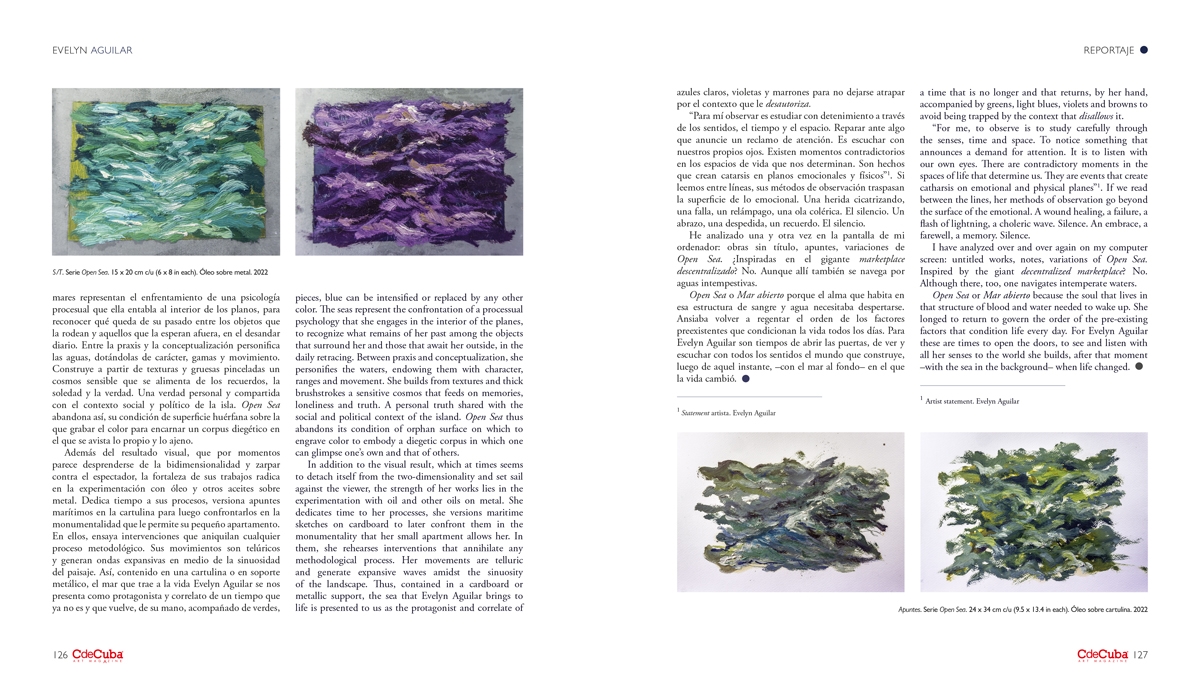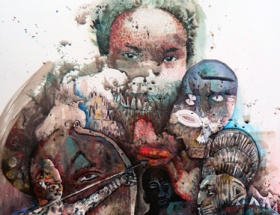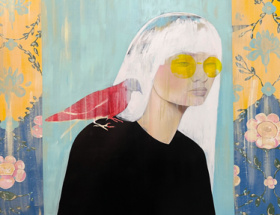Open Sea: Life Changed!
By Yudinela Ortega
The voice that comes out of my mouth is not the same one that comes out of my hands.
Jorge Terrones. Recuerdo
The work of Evelyn Aguilar (Artemisa, Cuba, 1991), contains the boldness of someone who needs to be embedded in space in order to build narratives. That is why she insists on reminding us that her works are based on the intrinsic experience shared with others: her family, her friends, their absence and objects. An experience that moves from the personal to the collective.
We recognize in her production the will to recover universal stories contained in books and recycle them as the sap for other narratives. We notice her capacity to establish dialogues between the individual and her objectual extensions, the last redoubt of themselves and of us. Thus, by interrelating the reflective exercises provoked in the human being by verbal tenses, actions and their consequences, she has documented subjects and objects, has calligraphed the faces of memory and has swum dry in the waters of reconciliation.
For Evelyn Aguilar, life changed. Perhaps it happened suddenly or it was a slow process like the calm sea that devours the earth centimeter by centimeter. And in the metamorphosis of a known reality, Open Sea (2021-), her most recent series, was born.
Open Sea is a state of mind in which she has been immersed during the last few months. It is the first step of a journey that has drawing as its antecedent, specifically her handwritten diaries. Calligraphic essays that on paper and metal have served as a support to transcribe her domestic space.
The artist arrives at the Open Sea, after living the confinement caused by COVID-19 close to her loved ones, but far from Cuba and the sea. When she returned to the island, everything had changed. She found herself in a time to which she no longer belonged and which required her to reconfigure the scenarios that had previously held her and her work.
Painting, that unexplored area until then, received her in the living room of her small apartment. There she coexists between everyday life, color studies, tradition, the adventure of large format and metal. And so she begins to rehearse an imagined sea, a sea of oil that tears the limits of any objection. Because if a motif has transversally crossed the arc of time within the Cuban plastic arts, it has been that overflowing mass that surrounds the island, that expands and constrains it. The seascapes of Romañach and Chartrand, the horizon of Collazo’s The Siesta, the shore of Mariano’s Landscape With Figures, the lines that support Manuel Mendive’s Slave Ship, Martínez Pedro’s Territorial Waters, Salvador Corratgé’s voluptuous abstraction… The sea with its gradients and colors has penetrated Cuban plastic arts. It has found in it a powerful weapon, capable of constructing perpetual ideas of what it symbolizes attached to the margins that surround the tension of our homeland.
Aware of the tradition that precedes her in her approach to the sea as the paladin and stage of the history of the Cuban nation, the artist revisits the pictorial tradition and adds her own discoveries.
The freedom of the large format, –another unknown terrain– gives her physical and symbolic space to let her imagination run wild. There, she dares with abstraction to search for the character of her personal sea. Attached to a state of contemplation that we could place in those bucolic scenes of a calm paradise, she narrates the fate of a life that has changed.
The artist, like a Sibyl, listens to the prophecy dictated by the tremendous swell. In the horizon that we have to imagine in front of the pieces, blue can be intensified or replaced by any other color. The seas represent the confrontation of a processual psychology that she engages in the interior of the planes, to recognize what remains of her past among the objects that surround her and those that await her outside, in the daily retracing. Between praxis and conceptualization, she personifies the waters, endowing them with character, ranges and movement. She builds from textures and thick brushstrokes a sensitive cosmos that feeds on memories, loneliness and truth. A personal truth shared with the social and political context of the island. Open Sea thus abandons its condition of orphan surface on which to engrave color to embody a diegetic corpus in which one can glimpse one’s own and that of others.
In addition to the visual result, which at times seems to detach itself from the two-dimensionality and set sail against the viewer, the strength of her works lies in the experimentation with oil and other oils on metal. She dedicates time to her processes, she versions maritime sketches on cardboard to later confront them in the monumentality that her small apartment allows her. In them, she rehearses interventions that annihilate any methodological process. Her movements are telluric and generate expansive waves amidst the sinuosity of the landscape. Thus, contained in a cardboard or metallic support, the sea that Evelyn Aguilar brings to life is presented to us as the protagonist and correlate of a time that is no longer and that returns, by her hand, accompanied by greens, light blues, violets and browns to avoid being trapped by the context that disallows it.
“For me, to observe is to study carefully through the senses, time and space. To notice something that announces a demand for attention. It is to listen with our own eyes. There are contradictory moments in the spaces of life that determine us. They are events that create catharsis on emotional and physical planes”1. If we read between the lines, her methods of observation go beyond the surface of the emotional. A wound healing, a failure, a flash of lightning, a choleric wave. Silence. An embrace, a farewell, a memory. Silence.
I have analyzed over and over again on my computer screen: untitled works, notes, variations of Open Sea. Inspired by the giant decentralized marketplace? No. Although there, too, one navigates intemperate waters.
Open Sea or Mar abierto because the soul that lives in that structure of blood and water needed to wake up. She longed to return to govern the order of the pre-existing factors that condition life every day. For Evelyn Aguilar these are times to open the doors, to see and listen with all her senses to the world she builds, after that moment –with the sea in the background– when life changed.
- Artist statement. Evelyn Aguilar






